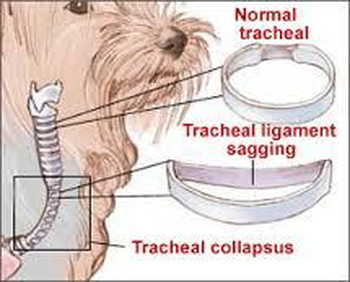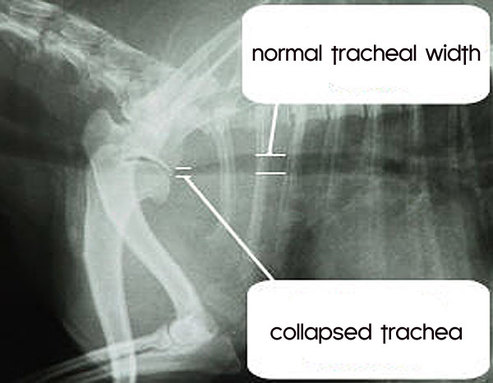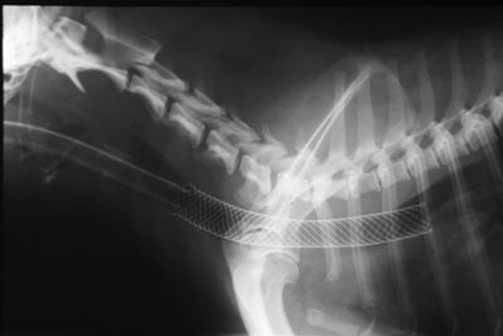Tracheal Collapse in Dogs

The trachea, commonly known as the "windpipe", is the tube that connects the mouth to the lungs. This tube is composed of numerous rings of cartilage held together by a tracheal ligament. If the ligament stretches, the ring of cartilage is allowed to flatten which makes a narrower opening for the air to pass through.
Flattening of the cartilage rings may occur throughout the entire trachea or may occur in only certain areas, but, regardless of location, causes breathing difficulty and a honking cough. Coughing can be exacerbated by excitement, exercise, obesity, swallowing, high humidity weather, airborne irritants like smoke, or by pressure on the trachea (such as with leash use).
Tracheal collapse in most common in small breeds such as Pomeranians, Shih Tzus, Lhasa Apsos, Toy Poodles, Chihuahuas, and Yorkshire terriers.
Tracheal collapse is diagnosed by physical exam and imaging. Palpation of the trachea can often illicit a dry, persistent cough. Xrays can be used to investigate the width of the trachea, but can also appear normal if the dog is not experiencing symptoms at the moment that the xray is taken. Advanced imaging such as endoscopy may be needed. During endoscopy, a small flexible camera is inserted down the anesthetized pets trachea in order to see movement in real time. (Other diseases that can appear similar to tracheal collapse may include: upper respiratory infections, lung disease, and heart disease).
Flattening of the cartilage rings may occur throughout the entire trachea or may occur in only certain areas, but, regardless of location, causes breathing difficulty and a honking cough. Coughing can be exacerbated by excitement, exercise, obesity, swallowing, high humidity weather, airborne irritants like smoke, or by pressure on the trachea (such as with leash use).
Tracheal collapse in most common in small breeds such as Pomeranians, Shih Tzus, Lhasa Apsos, Toy Poodles, Chihuahuas, and Yorkshire terriers.
Tracheal collapse is diagnosed by physical exam and imaging. Palpation of the trachea can often illicit a dry, persistent cough. Xrays can be used to investigate the width of the trachea, but can also appear normal if the dog is not experiencing symptoms at the moment that the xray is taken. Advanced imaging such as endoscopy may be needed. During endoscopy, a small flexible camera is inserted down the anesthetized pets trachea in order to see movement in real time. (Other diseases that can appear similar to tracheal collapse may include: upper respiratory infections, lung disease, and heart disease).
Tracheal collapse can be treated medically or surgically.
Medical treatment is life long and may involve bronchodilators or anti-inflammatory medications. In some situations, antibiotics may be necessary. Medical therapy only treats the symptoms and does not correct the problem, so these dogs are always subject to recurrence of coughing and breathing difficulty.
If medical therapy is not successful, the dog may be a surgical candidate. Before surgery can be performed, endoscopy is needed to determine which part of the trachea is collapsing. If the trachea is collapsing in the neck area, then surgery may be very beneficial. If the trachea is collapsing inside the chest, the surgery is typically not an option. Surgery, if performed, typically involves insertion of a permanent support device in order to keep the tracheal rings in a normal, open position.
In all cases, the pet needs achieve a lean body weight as excess weight will worsen symptoms of tracheal collapse. All affected pets should avoid using leashes in favor of harness that do not put pressure on the neck. All affected pets should avoid increased activity in times of high humidity weather or environments with smoke or other irritants.
Medical treatment is life long and may involve bronchodilators or anti-inflammatory medications. In some situations, antibiotics may be necessary. Medical therapy only treats the symptoms and does not correct the problem, so these dogs are always subject to recurrence of coughing and breathing difficulty.
If medical therapy is not successful, the dog may be a surgical candidate. Before surgery can be performed, endoscopy is needed to determine which part of the trachea is collapsing. If the trachea is collapsing in the neck area, then surgery may be very beneficial. If the trachea is collapsing inside the chest, the surgery is typically not an option. Surgery, if performed, typically involves insertion of a permanent support device in order to keep the tracheal rings in a normal, open position.
In all cases, the pet needs achieve a lean body weight as excess weight will worsen symptoms of tracheal collapse. All affected pets should avoid using leashes in favor of harness that do not put pressure on the neck. All affected pets should avoid increased activity in times of high humidity weather or environments with smoke or other irritants.


